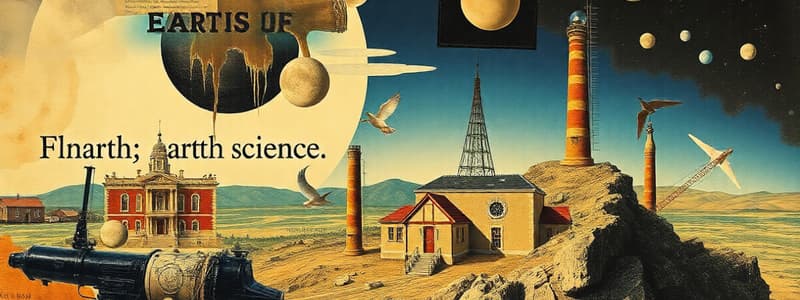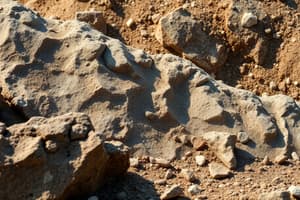Podcast
Questions and Answers
What is the primary focus of oceanography?
What is the primary focus of oceanography?
- Examining historical geological processes
- Understanding the Earth's structure and materials
- Investigating tides, waves, and changes in the ocean (correct)
- Studying the weather patterns of Earth
Which branch of Earth science is concerned with predicting and analyzing weather patterns?
Which branch of Earth science is concerned with predicting and analyzing weather patterns?
- Geology
- Meteorology (correct)
- Astronomy
- Oceanography
What does the root word 'geo' in 'geology' signify?
What does the root word 'geo' in 'geology' signify?
- Relating to the sky
- Relating to Earth (correct)
- Study of life
- Study of the universe
Which of the following is NOT a sub-branch of geology?
Which of the following is NOT a sub-branch of geology?
How is scientific terminology often broken down for better understanding?
How is scientific terminology often broken down for better understanding?
What is the first step in the scientific method?
What is the first step in the scientific method?
Which term describes the variable that is changed during an experiment?
Which term describes the variable that is changed during an experiment?
How are empirical data obtained?
How are empirical data obtained?
What would occur if biases affect an experiment?
What would occur if biases affect an experiment?
In which situation would a line graph be appropriately used?
In which situation would a line graph be appropriately used?
What does the term 'geologic time scale' refer to?
What does the term 'geologic time scale' refer to?
What fundamental change occurs during beta decay?
What fundamental change occurs during beta decay?
Which of these is NOT a step in the experimental design process?
Which of these is NOT a step in the experimental design process?
Which method is NOT associated with radiometric dating?
Which method is NOT associated with radiometric dating?
Which condition is least favorable for fossil preservation?
Which condition is least favorable for fossil preservation?
Index fossils are most valuable because they help to:
Index fossils are most valuable because they help to:
What is the significance of the principle of superposition in geology?
What is the significance of the principle of superposition in geology?
What is the primary method used to determine the relative age of rock layers?
What is the primary method used to determine the relative age of rock layers?
Which principle states that rock layers are deposited horizontally?
Which principle states that rock layers are deposited horizontally?
What is radiometric dating primarily based on?
What is radiometric dating primarily based on?
Which term describes a disruption between discontinuous layers of rock?
Which term describes a disruption between discontinuous layers of rock?
Which principle asserts that younger rocks are found above older rocks?
Which principle asserts that younger rocks are found above older rocks?
What does the process of alpha decay involve?
What does the process of alpha decay involve?
What geological concept explains that current geological processes are the same as those in the past?
What geological concept explains that current geological processes are the same as those in the past?
How does numerical dating differ from relative dating?
How does numerical dating differ from relative dating?
What event marks the transition between geological eras like the Mesozoic and Cenozoic?
What event marks the transition between geological eras like the Mesozoic and Cenozoic?
Which scientist is known as the Father of Modern Geology?
Which scientist is known as the Father of Modern Geology?
Flashcards are hidden until you start studying
Study Notes
Earth Science
- Earth science studies Earth and planets surrounding it
- Key branches include geology, meteorology, astronomy, and oceanography
- Geology focuses on Earth's structure, composition, and history
- Meteorology studies weather, climate, and the upper atmosphere
- Oceanography examines oceans, tides, waves, and their impact on climate
- Astronomy explores the universe beyond Earth
Scientific Terminology
- Greek and Latin are fundamental in scientific vocabulary
- Word parts (prefixes, root words, suffixes) are essential for understanding scientific terms.
- Root words are the core of a term, prefixes precede the root, and suffixes follow it
- Learning styles include auditory (hearing), visual (seeing), hands-on (experiencing), or a combination of these.
- Holistic learning integrates prior knowledge to understand new concepts
- Analytic learning breaks down information into smaller parts.
The Scientific Method
- A systematic process used by scientists to investigate phenomena
- Steps include defining a question, conducting research, forming a hypothesis, designing an experiment, analyzing data, and drawing conclusions.
- Experiments should be replicable to ensure accuracy and reliability
- A well-supported hypothesis can evolve into a scientific theory.
- Biases can invalidate experiments if they influence the scientific process.
Experimental Design
- Involves defining variables, formulating hypotheses, creating an experimental process, assigning subjects, and measuring the dependent variable.
- Important to research and understand the subject thoroughly before conducting experiments.
- Careful and complete execution of the five steps is crucial for a successful experiment.
The International System of Units (SI)
- The standard system of measurement, based on a decimal system (factor of 10).
- Prefixes are used to indicate large or small magnitudes.
- Key units include: meter (length), kilogram (mass), cubic meter (volume), kilogram per cubic meter (density), and Kelvin (temperature).
- Conversion factors facilitate conversions between units
- Units to be removed should be placed in the denominator, while desired units go in the numerator.
Scientific Experiments and Data Display
- Scientific experiments typically involve six steps: observation, hypothesis formation, experiment design and execution, data collection and evaluation, hypothesis acceptance or rejection, and potential refinement of the hypothesis.
- Data can be presented in various ways for analysis and trend identification:
- Line graphs: comparing small changes over time, numerical data
- Bar charts: comparing larger changes or differences between groups, numerical and categorical data
- Pie charts: comparing percentages, numerical and categorical data
- Flow charts: illustrating relationships between concepts or process steps, non-numerical data
- Line graphs depict relationships between dependent and independent variables.
- The x-axis (horizontal) represents the independent variable (cause), while the y-axis (vertical) represents the dependent variable (effect).
Geologic Time Scale
- A timeline depicting Earth's history, spanning 4.6 billion years
- Divided into eons, eras, periods, and epochs, each representing distinct events and organisms
- Eons are the largest units, covering hundreds to thousands of millions of years.
- Eras span tens to hundreds of millions of years.
- Scientists study rock layers (strata) to understand past environments.
- Relative age dating uses fossils and rock layer positions to determine age.
- Radiometric dating provides absolute age calculations.
Catastrophism vs. Uniformitarianism
- Catastrophism: Earth's features formed through sudden, violent, global events, including mass extinctions.
- Georges Cuvier, a proponent of catastrophism, estimated Earth's age to be several million years based on the fossil record.
- Uniformitarianism: Earth's features were shaped gradually over time by processes observed today (weathering, erosion, volcanism, plate tectonics).
- James Hutton, known as the "Father of Modern Geology," is associated with uniformitarianism.
- Modern geology acknowledges both catastrophic events and the influence of gradual processes in shaping Earth's history.
Relative and Numerical Dating
- Relative Dating: Comparing the ages of rock layers or fossils based on their positions or relationships.
- Principles of relative dating:
- Uniformitarianism: Past processes are similar to present ones
- Original Horizontality: Rock layers are initially deposited horizontally
- Lateral Continuity: Continuous layers can be separated, but remain part of the same unit
- Superposition: Older layers are below younger layers
- Cross-cutting Relationships: Features cutting across layers are younger
- Inclusions: Inclusions are older than the surrounding rock
- Baked Contacts: Heated rocks are older than the igneous rock that heated them
- Numerical (Radiometric) Dating: Using the decay of radioactive isotopes within rocks to calculate their age.
- Used for precise age determination, often applied to specific samples.
Fossil Preservation
- Factors influencing fossil preservation:
- Rapid burial: Quick burial protects remains from decay and erosion
- Hard parts: Bones, shells, and teeth are more likely to fossilize
- Environmental conditions: Cold and dry environments are more favorable.
- Large, bony organisms with rapid burial in aquatic environments have the highest fossilization potential.
- Small, soft-bodied organisms that died in exposed areas with warm and moist conditions are less likely to fossilize.
Index Fossils
- Fossils of organisms that lived for short geological time periods and are found in wide geographic areas.
- Used to correlate rock layers and determine their relative ages.
- Examples include ammonites, trilobites, and graptolites.
- The principle of fossil succession states that specific fossil assemblages are only found within limited geological time frames.
The Periodic Table
- An organizational model for all known elements.
- Arranged based on the number of protons in each element's atom.
- Johann Dobereiner created the Law of Triads, grouping similar elements in threes.
- John Newlands proposed the Law of Octaves, noting similarities in every eighth element.
- Dmitri Mendeleev is recognized as the "Father of the Periodic Table" for his contributions to the modern version.
- Henry Moseley refined the periodic table by arranging it according to the number of protons (atomic number).
The Periodic Table
- The periodic table is organized into rows called periods and columns called groups.
- Elements are classified as metals, nonmetals, or metalloids.
- Trends in the periodic table help predict element properties like valence electrons, atomic radius, ionization energy, electronegativity, electron affinity, oxidizing nature, and metallic character.
Elements and Atoms
- All matter is composed of elements, which are pure substances that cannot be broken down further.
- Elements are made up of atoms, each with a unique number of protons, neutrons, and electrons.
- Each element has a unique atomic number, equal to its number of protons, which also determines its number of electrons.
- The atomic number influences an element's properties and how it interacts with other elements.
Molecules and Compounds
- Molecules are formed when atoms bond chemically.
- Molecules can be composed of one type of atom (e.g., H2) or multiple types of atoms (e.g., CH3Cl).
- Chemical bonds can be ionic or covalent, leading to the classification of compounds as ionic or covalent.
- Pure substances contain only one type of compound, while mixtures contain two or more compounds or elements that don't form bonds.
Matter and Its Properties
- Matter is anything with mass and volume.
- Matter has physical and chemical properties.
- Physical properties don't change a substance's composition, while chemical properties involve changes in composition.
- Matter can be divided into pure substances (elements and compounds) and mixtures.
- Examples of physical properties include color, mass, and density.
- Chemical properties include pH and reactivity.
Chemical Bonds
- Ionic bonds occur between metals and nonmetals when a metal atom donates an electron to a nonmetal.
- The resulting ionic compound has a neutral charge due to the formation of positive and negative ions.
- The number of electrons in the outer shell determines ionic bond formation.
- Covalent bonds occur between nonmetals when atoms share electrons.
- Covalent bonds are generally stronger than ionic bonds.
Types of Covalent Bonds
- Non-polar covalent bonds: Occur between atoms with similar electronegativity, where electrons are shared equally.
- Polar covalent bonds: Occur between atoms with different electronegativity, where electrons are shared unevenly.
Other Bond Types
- Metallic bonds: Occur between metal atoms, involving a "sea" of electrons.
- Hydrogen bonds: Form between hydrogen atoms and other atoms with a dipole.
Studying That Suits You
Use AI to generate personalized quizzes and flashcards to suit your learning preferences.




